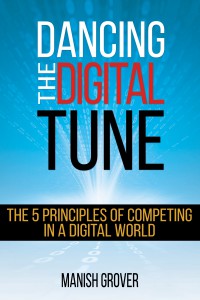The term digital strategy has to be the most confused term ever.
Is it digitization where we try to convert existing processes to the digital format? Think document capture, automated workflows etc.
Is it development of digital channels such as websites, mobile and social media where everything online or latest is considered the world of digital, and everything else considered “not digital”?
Is it about improving human performance?
So what is digital strategy? Digital strategy is not about digital technologies at all. Instead, it’s the way organizations should plan to compete in a world that is increasingly digital and connected. And in doing so, technology will obviously be used. But the focus is on how to execute or develop a new age business process, and not about how to use cool technology to do something. The following 5 broad categories sum it up for the most part:
- Connecting with customers: creating experiences that include channels and interactions. A retail customer who’s on the website must be contextually addressed in the store, and in our emails. Anyone not doing it may be making all the cool investments, but they do not really have a digital strategy. They just have ways to improve their digital channels, or give a digital technology flavor to their channels. Having a digital strategy means that they will think of the entire journey including planning of inventory, linking demand and supply planning, enabling store associates, applying coupons previously sent to the customer, targeting customers in a personalized & individual manner, making context available to customer service, managing foot traffic based on social media etc. Of course, it goes without saying that you may not address everything at once, but you must have a roadmap.
- Operating efficiently: Creating mechanisms which will improve or overhaul the way a complete business processes is executed. This could be on-boarding suppliers, assessing people performance, enabling employee collaboration, improving your returns process, tracking inventory movement etc. The important thing is to improve a complete business process while also evaluating its inter-linkages. In that light, installing a document capture tool at hotel locations to scan customer coupons is not a digital strategy. Instead if we just do that, it will be like converting an inefficient process to be an even more inefficient process. The real digital strategy is to think about how to get these coupons on mobile so the waste in the entire process is avoided. Often, improving operational efficiency also means improving customer experiences, or is linked strongly to it.
- Creating new models and differentiating: In these times of disruption, we need to be always looking at how to refine or change our business models so we stay relevant? Amazon leapfrogged Walmart because they created a supplier ecosystem and marketplace? Uber disrupted taxicabs because taxicab companies did not follow suit? Nokia was decimated because unlike Samsung, it decided to stick for too long on its own OS and then tried to align with another failing system from Microsoft? GE is evolving to make its equipments business more aligned to as-a-service models by investing in software? Adobe aligned itself to the adjacent marketing technology business while IBM and Oracle could not. Banks are feeling the pinch from mobile payments and from online lending platforms. Examples are endless and we must keep thinking of how to differentiate in this emerging digital world. What’s unique about us? Why should customers stick to us, or buy from us? That’s the only way to escape the depths of commoditization.
- Connecting your business: The biggest problem with agility for large businesses – or legacy businesses – if that they don’t connect their own business engines with each other. How often have you seen a product division helping to sell products from other divisions. Consider banking – their websites are segregated by their own internal silos. How will they ever promote financial well being of their customers? Consider a department store – an electronics associate doesn’t even bother to look at my cart full of children’s toys. In a fractured model like this, the disruptors will win because their focus on transactions alone will be cheaper and better than incumbent businesses. And legacy businesses will be left playing the game on their turf. A digital strategy is about uniting your business, and changing the way the game is played.
- Connecting with other businesses: We live in a connected world today. And that gives a whole new meaning to customer centricity. A digital strategy is about complementing the value we provide with what other businesses bring to the table. When we shop for groceries, our shopping is influenced by many different activities. We may be preparing for a marathon, or go to a fitness center, or throw frequent parties, or are fond of cooking new recipes. A digital strategy is about bringing these multiple facets of a customer together so we can help them as a person, instead of someone rolling a cart through the store who must be given as many price discount offers we can. Health insurance firms and fitness centers have already begun to do this because they realized this synergy. That’s digital strategy – thinking about how to compete in a digital world that expects businesses to draw these inferences.
How should we compete in today’s digital, connected world, instead of finding applications for new technology available? That’s the answer that will give rise to a digital strategy. Technologies such as mobile, big data, analytics, IoT, content management, campaigns, portals, augmented reality and others will obviously be used. But if we start with those, we’ll lose sight of our digital strategy.
Photo credit: Vintuitive via Foter.com / CC BY
I wrote the book Dancing The Digital Tune: The 5 Principles of Competing in a Digital World to answer this in much more detail. Read more and get it here at 40% off.


